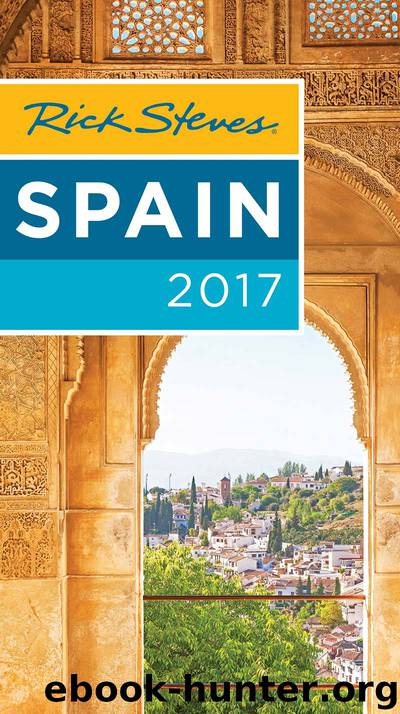Rick Steves Spain 2017 by Rick Steves

Author:Rick Steves
Language: eng
Format: epub
Publisher: Avalon Travel
Published: 2016-11-22T16:00:00+00:00
Segovia Walk
(See “Segovia” map, here.)
This 15-minute self-guided walk goes uphill from the Roman aqueduct to the city’s main square along the pedestrian-only street. It’s most enjoyable just before dinner, when it’s cool and filled with strolling Segovians.
Start at Plaza del Azogüejo, at Segovia’s emblematic Roman aqueduct (described later, under “Sights in Segovia”). Walk about 100 yards up Calle de Cervantes, which becomes Calle Juan Bravo, until you reach the “house of a thousand beaks” (Casa de los Picos) on your right. This building’s original Moorish design is still easy to see, despite the wall just past the door that blocks your view from the street. This wall, the architectural equivalent of a veil, hid this home’s fine courtyard—Moors didn’t flaunt their wealth. You can step inside to see art students at work and perhaps an exhibit on display, but it’s most interesting from the exterior. Notice its truncated tower, one of many fortified towers that marked the homes of feuding local noble families. In medieval Spain, clashing loyalties led to mini-civil wars. In the 15th century, as Ferdinand and Isabel centralized authority in Spain, nobles were required to lop their towers. You’ll see the once-tall, now-stubby towers of 15th-century noble mansions all over Segovia. Another example of a similar once-fortified, now-softened house with a cropped tower is about 50 yards farther down the street, on the left, on tiny Plaza del Platero Oquendo.
Continue uphill until you come to the complicated Plaza de San Martín, a commotion of history surrounding a striking statue of Juan Bravo. When Charles V, a Habsburg who didn’t even speak Spanish, took power, he imposed his rule over Castile. This threatened the local nobles, who, inspired and led by Juan Bravo, revolted in 1521. Although Juan Bravo lost the battle—and his head—he’s still a symbol of Castilian pride. This statue was erected in 1921 on the 400th anniversary of his death.
In front of the Juan Bravo statue stands the bold and bulky House of Siglo XV. Its fortified Isabelino style was typical of 15th-century Segovian houses. Later, in a more peaceful age, the boldness of these houses was softened with the decorative stucco work—Arabic-style floral and geometrical patterns—that you see today (for example, in the big house across the street). The 14th-century Tower of Lozoya, behind the statue, is another example of the lopped-off towers.
On the same square, the 12th-century Church of St. Martín is Segovian Romanesque in style (a mix of Christian Romanesque and Moorish styles).
If you continue up the street another 100 yards, you’ll see the Corpus Christi Convent on the left. For a donation, you can pop in to see the Franciscan church, which was once a synagogue, which was once a mosque. While sweet and peaceful, with lots of art featuring St. Francis, the church is skippable.
Veer right at the fork directly after the convent, and keep going until you reach Segovia’s inviting Plaza Mayor—once the scene of executions, religious theater, and bullfights with spectators jamming the balconies. The bullfights ended in the 19th century.
Download
This site does not store any files on its server. We only index and link to content provided by other sites. Please contact the content providers to delete copyright contents if any and email us, we'll remove relevant links or contents immediately.
Annapurna by Maurice Herzog(2845)
Liar's Poker by Michael Lewis(2817)
A Forest Journey by John Perlin(2588)
Atlas Obscura by Joshua Foer(2351)
Cuba by Lonely Planet(2190)
The Ogre by Doug Scott(2118)
Photographic Guide to the Birds of Indonesia by Strange Morten;(2091)
Tokyo by Rob Goss(2022)
All Things Reconsidered by Bill Thompson III(1963)
A TIME OF GIFTS by Patrick Leigh Fermor(1851)
DK Eyewitness Top 10 Travel Guides Orlando by DK(1817)
Abbey in America by Murray John A(1802)
Fatal Storm by Rob Mundle(1792)
The Splendid and the Vile by Erik Larson(1789)
Trail Magic by Trevelyan Quest Edwards & Hazel Edwards(1762)
INTO THE WILD by Jon Krakauer(1730)
Top 10 Dubai and Abu Dhabi by DK Travel(1718)
Touching the Void by Joe Simpson(1713)
Lonely Planet Australia by Lonely Planet(1679)
